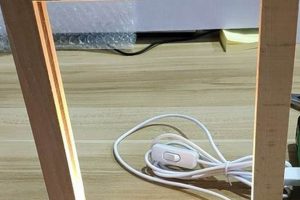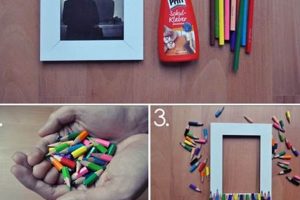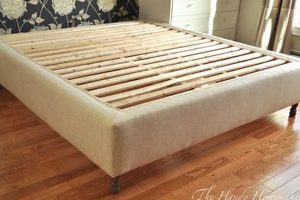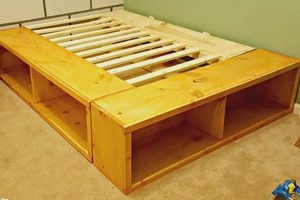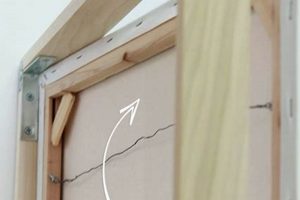The construction of a motorized vehicle chassis from readily available materials, intended for off-road recreational use, constitutes a popular do-it-yourself project. Such endeavors typically involve the welding or bolting together of metal tubing to create a structurally sound base upon which an engine, wheels, and steering components can be mounted. A common example includes fabricating a small, four-wheeled vehicle designed for racing on private tracks or open fields.
Undertaking this type of project offers several advantages, including cost savings compared to purchasing a pre-built vehicle and the opportunity to customize the design to specific needs and preferences. Historically, the creation of these vehicles stems from a desire for accessible motorsports and innovative engineering solutions. The resulting vehicles are often lighter and more maneuverable than commercially available alternatives.
This article will explore key considerations in this construction, including material selection, design principles, welding techniques, and safety measures. Furthermore, it will address common challenges encountered during the fabrication process and offer solutions for achieving a reliable and enjoyable final product.
Tips for Constructing a Go Kart Frame
Successful construction of a reliable go kart frame necessitates careful planning, precise execution, and adherence to safety protocols. These tips offer guidance to ensure structural integrity and optimal performance of the final product.
Tip 1: Thoroughly Research Frame Designs: Prior to commencing construction, a comprehensive understanding of various frame designs is crucial. Analyze the pros and cons of each design based on intended use, material availability, and skill level. Blueprints and online resources provide valuable insights.
Tip 2: Prioritize Material Selection: The choice of materials directly impacts the frame’s strength, weight, and durability. Steel tubing, typically mild steel or chromoly steel, is a common choice. Select tubing with appropriate wall thickness and diameter to withstand anticipated stresses.
Tip 3: Employ Precise Cutting and Welding Techniques: Accurate cutting and welding are paramount for ensuring structural integrity. Use precision tools such as miter saws or plasma cutters for clean cuts. Employ proper welding techniques, such as MIG or TIG welding, and ensure adequate penetration and weld quality.
Tip 4: Incorporate Reinforcements at Stress Points: Identify areas of high stress, such as suspension mounting points and engine mounts. Reinforce these areas with gussets or additional tubing to prevent fatigue and failure.
Tip 5: Account for Component Placement: Before welding the frame, meticulously plan the placement of all components, including the engine, steering system, brakes, and seat. Ensure adequate clearance and accessibility for maintenance.
Tip 6: Verify Frame Alignment: Following welding, meticulously check the frame for proper alignment. Use a level, square, and measuring tape to ensure that all components are square and true. Misalignment can lead to handling issues and premature wear.
Tip 7: Prioritize Safety Throughout the Process: Wear appropriate safety gear, including eye protection, gloves, and a welding helmet, during all phases of construction. Work in a well-ventilated area and follow established safety protocols for welding and metalworking.
Adhering to these guidelines will enhance the likelihood of constructing a durable, safe, and well-performing go kart frame. Careful planning and execution are essential for a successful outcome.
The subsequent sections of this article will delve deeper into specific aspects of frame construction, including suspension design and steering geometry.
1. Design selection
Design selection forms the foundational element of a successful do-it-yourself motorized vehicle frame project. It determines not only the aesthetic appearance of the final product but, more importantly, its structural integrity, handling characteristics, and overall safety. A poorly conceived design, regardless of the quality of materials or workmanship, will invariably result in a substandard, potentially hazardous vehicle. The correlation is direct: selecting a robust and well-engineered design is a primary causal factor in achieving a functional and safe end product. For instance, choosing a ladder frame design, known for its simplicity and ease of construction, may be suitable for low-speed recreational use. However, for higher speeds or more demanding applications, a space frame design, offering superior torsional rigidity and strength-to-weight ratio, would be a more appropriate selection. The importance of informed design selection cannot be overstated; it represents the most critical decision in the construction process.
Consider the practical implications of design choice. A design intended for off-road use must incorporate adequate ground clearance, robust suspension mounting points, and protection for critical components. Conversely, a design aimed at on-track performance should prioritize a low center of gravity, optimized weight distribution, and aerodynamic considerations. Real-world examples underscore the consequences of neglecting these factors. Frames built without considering the intended operating environment are prone to failure, resulting in accidents and potential injuries. Furthermore, a well-designed frame facilitates easier component integration and maintenance, contributing to the long-term usability and reliability of the vehicle.
In summary, design selection is a non-negotiable aspect of any do-it-yourself vehicle frame project. A thorough understanding of design principles, load distribution, and material properties is essential for making an informed choice. The challenges lie in balancing design complexity with available resources and skill levels. Successful projects invariably begin with a well-defined and appropriately selected design, setting the stage for a safe and enjoyable building experience. This crucial initial step is directly linked to the overall success and safety of the resulting go-kart.
2. Material strength
Material strength constitutes a critical parameter in the context of fabricating a motorized vehicle chassis. Its direct influence on the structural integrity and safety of the final product necessitates careful consideration during the design and construction phases. Selecting materials with inadequate strength compromises the frame’s ability to withstand operational stresses, leading to potential failure.
- Yield Strength and Frame Deformation
Yield strength represents the stress a material can withstand before undergoing permanent deformation. In a vehicle frame, exceeding the yield strength can result in bending, twisting, or cracking of frame members. For instance, using mild steel with a low yield strength in a high-stress area, such as the suspension mounting points, can lead to progressive deformation and ultimately structural failure during operation. This deformation directly affects vehicle handling and stability.
- Tensile Strength and Frame Fracture
Tensile strength denotes the maximum stress a material can endure before fracturing. A frame constructed from a material with insufficient tensile strength is susceptible to sudden and catastrophic failure under load. Consider a situation where a vehicle encounters a significant impact; if the frame material’s tensile strength is inadequate, it may fracture at the point of impact, potentially causing serious injury. Proper material selection mitigates this risk.
- Fatigue Resistance and Frame Longevity
Fatigue resistance refers to a material’s ability to withstand repeated stress cycles without failure. Vehicle frames are subjected to continuous vibrations and stress fluctuations during operation. A material with poor fatigue resistance will develop cracks over time, weakening the structure and ultimately leading to failure. For example, a poorly welded joint in a frame constructed from a material with low fatigue resistance is prone to cracking under repeated stress, significantly reducing the vehicle’s lifespan.
- Material Weight and Performance
Material strength is often correlated with density; stronger materials tend to be heavier. Balancing strength requirements with weight considerations is crucial for optimizing vehicle performance. The use of high-strength, lightweight alloys, such as chromoly steel, allows for the construction of frames that are both strong and agile. Conversely, over-engineering a frame with unnecessarily heavy materials can negatively impact handling and acceleration.
The interplay of these strength characteristics directly influences the reliability and safety of a do-it-yourself vehicle frame. The selection of appropriate materials, coupled with proper welding and fabrication techniques, is paramount for ensuring a robust and durable structure capable of withstanding the demands of its intended use. A thorough understanding of material properties and their implications is essential for a successful construction project.
3. Welding Proficiency
Welding proficiency represents a fundamental prerequisite for successful motorized vehicle chassis fabrication. The integrity and durability of the frame, and consequently the safety of the operator, are directly contingent upon the quality of the welds joining the frame components. Inadequate welding can result in structural weaknesses, premature failure, and potential accidents.
- Weld Penetration and Structural Integrity
Weld penetration refers to the depth to which the weld metal fuses with the base metal. Insufficient penetration creates a weak joint that is prone to cracking under stress. For example, if a frame joint lacks adequate penetration, vibrations and impacts during operation can initiate cracks, leading to eventual failure of the weld. This is more risky with go kart frame diy where experience often varies.
- Weld Bead Profile and Stress Concentration
The profile of the weld bead influences the distribution of stress within the joint. An irregular or undercut weld bead creates stress concentrations, making the joint more susceptible to fatigue failure. Consider a situation where a sharp transition exists between the weld and the base metal; this area becomes a focal point for stress, accelerating crack propagation under cyclic loading, this can be more costly in go kart frame diy if design is not proper.
- Weld Porosity and Material Weakness
Porosity, the presence of voids or gas pockets within the weld metal, reduces the overall strength of the weld. These pores act as stress concentrators and weaken the joint, increasing the risk of failure. If a weld is riddled with porosity, its ability to withstand tensile or shear forces is significantly compromised. This is very important to ensure the go kart frame diy can last longer.
- Welding Technique and Material Distortion
Improper welding techniques can introduce excessive heat into the base metal, leading to distortion and warping of the frame. This distortion can affect the frame’s alignment and handling characteristics. Overheating the metal or failing to use proper clamping techniques can cause permanent deformation, requiring costly rework. The best welding technique is crucial to improve your go kart frame diy creation.
The relationship between welding proficiency and the success of a motorized vehicle chassis project is therefore inextricably linked. Achieving sound and reliable welds requires not only technical skill but also a thorough understanding of welding principles, material properties, and safety precautions. Proper training, adherence to best practices, and careful inspection of welds are essential for ensuring the structural integrity and safety of the completed frame. This ensures a safer go kart frame diy experience.
4. Component integration
Component integration, in the context of constructing a motorized vehicle chassis, refers to the systematic incorporation of essential mechanical and electrical systems onto a pre-existing or newly fabricated frame. It is a crucial phase in the completion of a functional vehicle, directly influencing its performance, safety, and overall reliability. Improper integration can lead to operational inefficiencies, mechanical failures, and compromised safety.
- Engine Mounting and Powertrain Alignment
Correct engine mounting is paramount for efficient power transmission and minimizing vibration. Misalignment between the engine, transmission, and drive axle can result in premature wear on drivetrain components, reduced power output, and potential mechanical failure. For instance, an improperly aligned engine mount may induce excessive stress on the engine block or transmission housing, leading to cracking or breakage. Precise measurements and secure fastening are essential during this stage. It is the most important components for a go kart frame diy.
- Steering System Integration and Geometry
The steering system must be integrated to provide precise and predictable handling. Improper steering geometry, such as incorrect Ackerman angle or caster, can lead to unstable handling, excessive tire wear, and compromised steering responsiveness. For example, if the steering linkage is poorly designed or installed, the vehicle may exhibit excessive understeer or oversteer, making it difficult to control. Proper alignment and adjustment of the steering components are crucial for safe operation. It is important for a go kart frame diy
- Braking System Mounting and Hydraulic Lines
The braking system requires secure mounting of calipers, rotors, and master cylinders, along with proper routing of hydraulic lines. Loose or improperly mounted braking components can result in reduced braking performance, brake fade, or complete brake failure. For instance, if a brake line is routed too close to a heat source or is subjected to abrasion, it may rupture, leading to a loss of braking power. Thorough inspection and secure fastening of all braking components are essential for safe operation, which must be consider during go kart frame diy
- Electrical System Wiring and Component Placement
The electrical system necessitates careful wiring and component placement to prevent short circuits, voltage drops, and electrical fires. Improperly insulated wires or poorly grounded components can create hazardous conditions. For instance, if a wire rubs against a sharp edge or is exposed to moisture, it may short circuit, potentially causing a fire or damaging electronic components. Secure routing and proper insulation of all wiring are crucial for a reliable and safe electrical system in a go kart frame diy.
In summation, the successful integration of these systems is inextricably linked to the overall functionality and safety of the motorized vehicle. Each component must be meticulously installed and aligned to ensure optimal performance and prevent potential hazards. A comprehensive understanding of mechanical principles, coupled with careful attention to detail, is essential for achieving a reliable and safe end product in the scope of constructing a go kart frame diy.
5. Frame alignment
Frame alignment, in the context of a do-it-yourself motorized vehicle chassis project, represents a critical determinant of vehicle handling, stability, and tire wear. It signifies the precision with which the various components of the frameincluding the main chassis rails, suspension mounting points, and axle supportsare positioned relative to one another. Deviations from specified alignment parameters can induce a cascade of negative effects, ultimately compromising the vehicle’s performance and safety. As a core element of any successful “go kart frame diy”, misalignment introduces unintended stresses, leading to erratic handling and accelerated component degradation. For example, if the rear axle is not perfectly perpendicular to the longitudinal axis of the frame, the vehicle will exhibit a tendency to pull to one side, requiring constant steering correction. This inherent instability reduces driver control and increases the risk of accidents.
The significance of proper alignment extends beyond handling considerations. Misaligned frames induce uneven weight distribution across the tires, resulting in premature and irregular tire wear patterns. This not only increases operating costs but also compromises grip, further exacerbating handling issues. Additionally, misalignment places undue stress on suspension components, potentially leading to premature failure of springs, shocks, or bushings. From a practical perspective, achieving precise alignment requires the use of accurate measuring tools, such as levels, squares, and laser alignment systems. The fabrication process must incorporate meticulous attention to detail, ensuring that all frame components are positioned within specified tolerances. Welding techniques also play a crucial role, as improper welding can introduce distortion and alter frame geometry.
In conclusion, frame alignment is not merely a cosmetic concern but a fundamental aspect of vehicle engineering that directly impacts performance, safety, and longevity. Neglecting this crucial step in a “go kart frame diy” endeavor can lead to a range of problems, undermining the entire project. The challenges lie in achieving the required precision with limited resources and expertise. Overcoming these challenges necessitates a thorough understanding of alignment principles, access to appropriate measuring tools, and meticulous attention to detail throughout the fabrication process, resulting in a safer and more enjoyable vehicle.
6. Safety precautions
The intersection of safety precautions and motorized vehicle chassis construction from readily available materials is a critical area demanding stringent adherence to established safety protocols. The causal relationship between neglected safety measures and potential harm is direct and significant. A failure to prioritize safety during any phase of the “go kart frame diy” processfrom initial design and material selection to welding, component integration, and testingcan result in severe injuries, including burns, lacerations, fractures, or even fatalities. The importance of rigorous safety measures cannot be overstated, as they serve as the primary safeguard against inherent risks associated with metalworking, mechanical assembly, and vehicle operation. For instance, inadequate eye protection during welding can result in arc eye or permanent vision damage from flying debris.
Furthermore, the selection of appropriate personal protective equipment (PPE) is crucial. This includes wearing welding helmets with appropriate shade settings, gloves resistant to heat and sparks, and sturdy footwear. Ensuring a well-ventilated workspace minimizes the risk of inhaling harmful fumes produced during welding and cutting operations. Fire safety is another critical aspect, necessitating the availability of fire extinguishers and the removal of flammable materials from the work area. Implementing lockout/tagout procedures during electrical work prevents accidental energization of circuits, reducing the risk of electric shock. Thorough inspection of all tools and equipment before use is essential to identify and rectify any potential hazards. Real-world examples abound, illustrating the devastating consequences of neglecting these precautions. Individuals who forego PPE or fail to follow established safety procedures are disproportionately represented in accident statistics related to metalworking and vehicle construction.
In summary, safety precautions are not merely an optional consideration but an indispensable component of any successful “go kart frame diy” endeavor. A commitment to safety must permeate every aspect of the project, from initial planning to final testing. The practical significance of this understanding lies in the prevention of injuries, the reduction of liability, and the creation of a safer working environment. While the challenges associated with implementing comprehensive safety measures may seem daunting, the potential benefits far outweigh the costs. A proactive approach to safety is not only ethically responsible but also contributes to the overall success and enjoyment of the project.
7. Budget management
Budget management plays a critical role in the execution of a do-it-yourself motorized vehicle chassis project. The allocation and control of financial resources directly influence the scope, quality, and ultimately, the success of the build. Inadequate budget planning often leads to compromised material selection, rushed fabrication processes, and potential safety hazards, underscoring its importance. For example, a constrained budget might incentivize the use of lower-grade steel, thereby jeopardizing the structural integrity of the frame. This causal relationship highlights the need for a meticulously defined budget that accounts for all anticipated expenses.
Effective budget management necessitates a comprehensive understanding of material costs, tooling requirements, and potential unforeseen expenses. Creating a detailed spreadsheet that itemizes each component, its associated cost, and a contingency fund for unexpected issues is a sound practice. Comparing prices from multiple suppliers can yield significant cost savings. Furthermore, the strategic acquisition of used or refurbished tools, where appropriate, can contribute to overall budget efficiency. For instance, opting for a used welding machine in good working condition, rather than a new, high-end model, can free up resources for higher-quality materials or critical safety equipment. Regular monitoring of expenditures and adherence to the established budget are essential for preventing cost overruns and maintaining project momentum.
In summary, budget management is not merely a logistical consideration, but an integral component of a successful do-it-yourself vehicle frame project. Thorough planning, cost-conscious decision-making, and disciplined tracking of expenses are crucial for achieving a safe, reliable, and enjoyable outcome. Neglecting budget management can lead to project delays, compromised quality, and potential financial strain. Therefore, a proactive and strategic approach to financial resource allocation is paramount for realizing the full potential of the build.
Frequently Asked Questions
The following addresses common inquiries regarding the construction of a motorized vehicle chassis for recreational use. The information presented aims to provide clarity and guidance on key aspects of the fabrication process.
Question 1: What is the most critical factor influencing the safety of a DIY go kart frame?
The structural integrity of the frame is paramount. This depends directly on material selection, welding quality, and adherence to sound engineering principles during design and construction. Compromising on any of these factors can result in catastrophic failure and severe injury.
Question 2: Which welding process is best suited for go kart frame construction?
Gas Metal Arc Welding (GMAW), also known as MIG welding, and Gas Tungsten Arc Welding (GTAW), or TIG welding, are both suitable. GMAW offers a faster welding speed, while GTAW provides greater control over weld quality. The selection depends on skill level and available equipment.
Question 3: How should one approach the design of a go kart frame for off-road use?
Designs intended for off-road applications should incorporate increased ground clearance, reinforced suspension mounting points, and protection for vulnerable components such as the engine and fuel tank. A robust frame capable of withstanding significant impacts is essential.
Question 4: What type of steel is recommended for a DIY go kart frame?
Mild steel (e.g., 1018 steel) is a common and cost-effective choice for recreational go kart frames. For higher-performance applications, chromoly steel (e.g., 4130 steel) offers superior strength-to-weight ratio but requires more specialized welding techniques.
Question 5: How can frame alignment be accurately verified after welding?
Frame alignment should be checked using levels, squares, and measuring tapes. Laser alignment systems offer greater precision. Ensure that all critical dimensions and angles conform to the design specifications. Misalignment can lead to handling instability and premature component wear.
Question 6: What safety precautions are essential during go kart frame construction?
Mandatory safety measures include wearing appropriate eye protection (welding helmet, safety glasses), gloves, and protective clothing. Work in a well-ventilated area, use proper grounding techniques during welding, and maintain a fire extinguisher in close proximity. Always prioritize safety to prevent injuries.
Adherence to these guidelines and a commitment to safe practices are crucial for a successful and enjoyable go kart frame construction project.
The subsequent sections of this resource will provide further details on specific construction techniques and component selection considerations.
Conclusion
This exploration of go kart frame diy has illuminated the multifaceted nature of constructing a motorized vehicle chassis. Key considerations, encompassing design selection, material strength, welding proficiency, component integration, frame alignment, safety precautions, and budget management, represent critical determinants of project success. Neglecting any of these elements can lead to compromised structural integrity, impaired performance, and elevated safety risks.
The successful execution of go kart frame diy demands a commitment to thorough planning, meticulous execution, and unwavering adherence to safety protocols. While challenges may arise, a proactive and informed approach enhances the likelihood of creating a reliable and enjoyable vehicle. Prospective builders should approach this endeavor with diligence, recognizing the inherent responsibilities associated with constructing a motorized vehicle. Further investigation and continuous learning are encouraged to refine skills and promote safer building practices.


